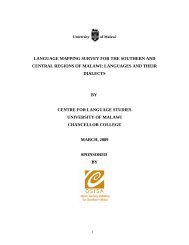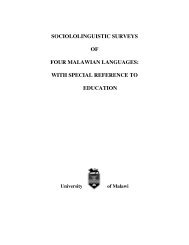languages and area spoken for chitipa - Centre for Language Studies
languages and area spoken for chitipa - Centre for Language Studies
languages and area spoken for chitipa - Centre for Language Studies
Create successful ePaper yourself
Turn your PDF publications into a flip-book with our unique Google optimized e-Paper software.
2.4 <strong>Language</strong>s of Mzimba<br />
The language situation in Mzimba is rather interesting as the district is sometimes<br />
portrayed as Cingoni-speaking. In fact the 1998 National Statistics Census survey data<br />
shows Mzimba as a predominantly Cingoni-speaking district. However, results from the<br />
survey show that Cingoni is no longer a significant language of the district but that<br />
Citumbuka is now the most dominant language <strong>spoken</strong> by nearly all the people of the<br />
district. Many people including chiefs interviewed during the survey contend that<br />
Cingoni used to be an influential language of the district but the scenario changed due to<br />
intermarriages between Ngoni men <strong>and</strong> Tumbuka women with the latter having more<br />
influence on the first language of children born out of such marriages. Todate, Cingoni is<br />
only limited to a few senior chiefs <strong>and</strong> indunas. The only place where traits of Cingoni<br />
are found is at Chief Mpherembe’s headquarters where the Chief <strong>and</strong> his indunas<br />
converse in the language. In an interview with Chief Mpherembe himself, he<br />
acknowledged the demise of the language in most parts of the district to the extent that<br />
deliberate ef<strong>for</strong>ts are being made to revive the Cingoni language <strong>and</strong> culture. Such ef<strong>for</strong>ts<br />
include the teaching of the language at the Mzuzu museum where materials being used<br />
are sourced from South Africa where Isizulu, a related dialect, is also <strong>spoken</strong>.<br />
There are also pockets of Citonga speakers in <strong>area</strong>s bordering Mzimba with Nkhatabay<br />
district especially in the <strong>area</strong> of Chief Khonsolo Gwaza. Table 4 in appendix 1 shows the<br />
<strong>languages</strong> <strong>spoken</strong> in Mzimba.<br />
2.5 <strong>Language</strong>s of Nkhatabay<br />
The results of the survey show that Nkhatabay has the following <strong>languages</strong>: Citonga,<br />
Citumbuka <strong>and</strong> Chichewa. Of the three, Citonga is the most common language <strong>and</strong> it is<br />
<strong>spoken</strong> in almost all the <strong>area</strong>s of the district. Citumbuka is <strong>spoken</strong> in <strong>area</strong>s along the lake<br />
bordering Rumphi in the north of the district especially in Mwausisya, Boghoyo,<br />
Mbwana (where the dialect is known as Cisisya), <strong>and</strong> in the west of Mzimba district. The<br />
Citonga <strong>spoken</strong> in these <strong>area</strong>s is largely influenced by Citumbuka especially in <strong>area</strong>s that<br />
border with Mzimba <strong>and</strong> Rumphi. Table 5 in appendix 1 shows the <strong>languages</strong> of<br />
Nkhatabay.<br />
19





